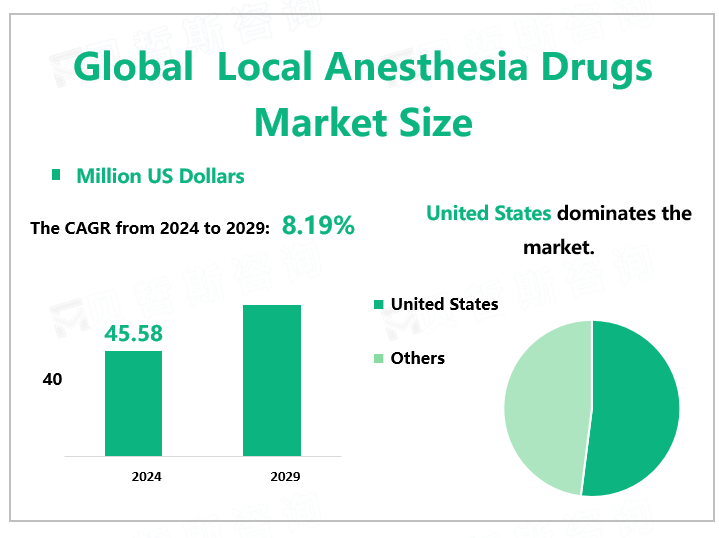Global Local Anesthesia Drugs Market Overview
According to Global Market Monitor, the global local anesthesia drugs market size will reach $3615.28 million in 2024 with a CAGR of 8.19% from 2024 to 2029.
Local anesthetics produce anesthetic effects by suppressing the excitation of nerve endings or blocking the conduction of peripheral nerves. It is used to numb certain parts of the body to prevent pain during the procedure.
Aging population Brings Opportunities for the Local Anesthetic Drugs Industry.
The global population is entering an aging phase. People over 65 is accounting for approximately 53% of all surgical procedures and is a key factor driving the anesthesia market. The number and proportion of the elderly in almost every country in the world are increasing, the elderly's physical function is declining, the stimulation of the external environment and the defense ability of pathogenic microorganisms are reduced, and they are more prone to chronic diseases, such as cardiovascular diseases, respiratory diseases, etc., which is the main group of medical resource consumption. Therefore, the aging population has brought great development opportunities to the local anesthesia industry.
Growing Health Care Spending in Developing Countries
With the development of the economy, the per capita disposable income has increased, and health concerns have gradually increased. More and more developing countries are spending more on health care. This means that more people can receive good treatment, which leads to an increase in the number of surgical procedures, which may increase the demand for local anesthetics.

US Dominates the Market.
The United States occupies the main market share with a market share of 39.6% in 2023. This can be attributed to an increase in the number of surgeries, an aging population with chronic conditions, an increase in the use of local anesthetics for postoperative pain, and advances in anesthesia management.
Local anesthetics are mainly used for ophthalmic anesthesia and analgesia. Compared to general anesthetics, local anesthetics are safer to use and have fewer side effects. Local anesthesia can be applied to the nose, eyes, skin, ears, mouth and other mucous membranes. As the number of surgical procedures continues to increase worldwide, the use of local anesthesia is becoming more widespread. In particular, the increase in the amount of dental and cosmetic surgery is rapidly promoting the development of the local anesthetic market. With the continuous development of medical technology, the use of local anesthetics has become increasingly common, especially in areas where medical technology is rapidly developing.
Ophthalmic local anesthetics can relieve pain. Local anesthetics stabilize the neuronal membrane and prevent the generation and spread of nerve impulses, thereby producing a local anesthetic effect. The subset of surgical procedures suitable for local eye anesthesia includes almost all intraocular surgical procedures including, for example, cataract extraction, corneal transplantation, glaucoma surgery, vitreoretinal surgery, scleral flexion, strabismus repair and excision.
|
By Type |
Articaine |
|
Ropivacaine |
|
|
Bupivacaine |
|
|
Lidocaine |
|
|
Mepivacaine |
|
|
Prilocaine |
|
|
Other |
|
|
Lidocaine segment contributes the largest market share. |
|
|
By Application |
Stomatology |
|
Ophthalmology |
|
|
Gynecology |
|
|
Other |
|
|
The ophthalmology segment occupies the biggest share. |
We provide more professional and intelligent market reports to complement your business decisions.